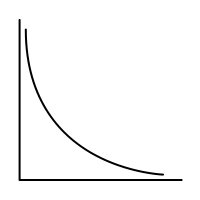Unit 6 - Photosynthesis
1/43
There's no tags or description
Looks like no tags are added yet.
Name | Mastery | Learn | Test | Matching | Spaced |
|---|
No study sessions yet.
44 Terms
Redox reactions
Oil Rig — oxidation is losing, reduction is gaining
have to happen in pairs
photosynthesis is a series of oxidation/reduction reactions!
anything stealing oxygen is the oxidizing agent/oxidizer
Photosynthesis
the transformation of matter and energy (a series of chemical reactions)
Only one kind of matter into another kind of matter, and one kind of energy to another kind of energy
What does photosynthesis do?
Turns CO2 and H2O into glucose and O2, and light energy → chemical energy the light energy is absorbed by the electrons of H and the energy is stored in the bonds of sugar)
What is Cellular Respiration?
Breaking apart the sugar and releasing the energy stored in the bonds
Turning the sugar into CO2 and Water, CO2 diffuses out, water is peed or sweated out
The Circle of Life
Light energy → plants → photosynthesis → oxygen & glucose → animals → cellular respiration → CO2 & H2O → plants (+ light energy)
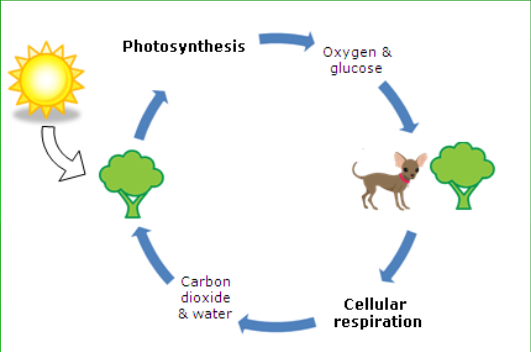
The Carbon Cycle
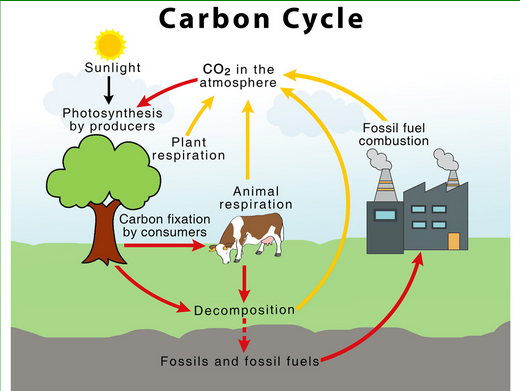
Food Web
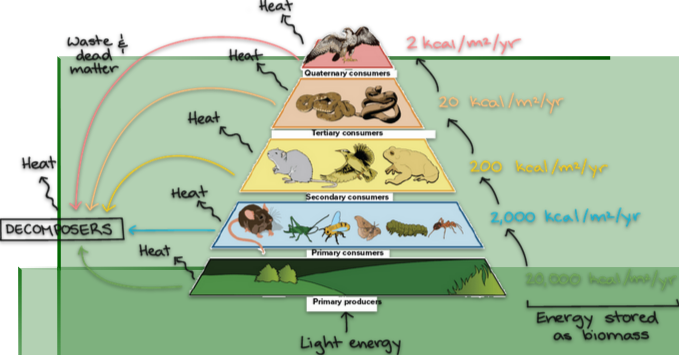
Parts of the Leaf
cuticle
epidermis
plastids
mesophyll
palisades
spongy
veins
xylem
phloem
stomates
guard cells
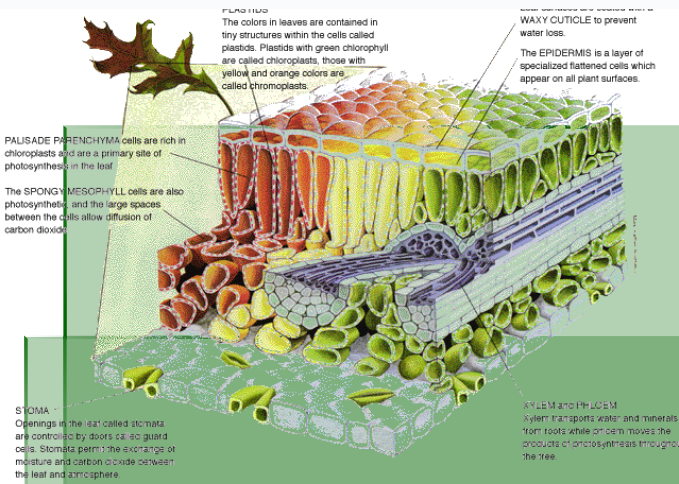
Cuticle
produced by epidermis
made of lipids
non-polar and therefore seals the cells so that no water which is polar can go through
Epidermis
protect leaf from disease and dehydration
it’s on the very outside of the leaf (top and bottom)
rectangular so they fit together tightly and do not allow anything to pass between the cells
Palisades
in the mesophyll
main photosynthetic cells
lined up in the same direction so more fit
at the top for better light absorption
not attached, better for CO2 and water circulation
long and thin
high SA/Vol for diffusion
loaded with plastids
green plastids are known as chloroplasts
yellow and orange are known as chromoplastsids
Spongy
in the mesophyll
away from sun but still maximize overall light absorption by providing more chloroplasts
at the bottom near the stomates where most of the CO2 enters so it can circulate and get to all of the cells that are photosynthetic more easily since
Don’t want too many stomates on top
veins
in the middle to supply water to and pick up food from the photosynthetic cells
made of many cells instead of being hollow to maximize adhesion to move the water from roots to leaves without supplying energy, and transports sugar away from leaves
also lots of strong cellulose to support the stem or trunk
many many little tubes
2 diff cells
xylem - sending water and minerals up
phloem (food) - sending sugar down
Stomates
holes that let CO2 in and O2 out
some on top, most on bottom
controlled by guard cells
allows them to let the gas exchange happen without losing too much water vapor
when really hot and dry, guard cells can close them and open them at night to collect CO2 to use for photosynthesis in the morning
bottom is cooler – lose less water
Parts of the Chloroplast
Thylakoid
Grana
Stroma
Chlorphyll
Thylakoid
flattened sacs made of membranes
contains chlorophyll, proton pumps, and electron carriers
site of light reactions
Grana
stack of Thylakoids
Stroma
liquid part around thylakoids
contains enzymes for Calvin cycle
contains DNA, RNA, and ribosomes so chloroplast can make few of its own proteins
Chlorophyll
colored pigment that absorbs the sun’s energy
absorbs red and blue visible light and reflects mainly green
How are chloroplasts structured for their function?
They have a double membrane that controls what enters and exits the organelle.
Inside, stacks of flattened membrane sacs called thylakoids are arranged into columns called grana, which provide a large surface area for light-dependent reactions.
These thylakoid membranes contain chlorophyll, the pigment that absorbs sunlight.
The surrounding fluid, known as the stroma, contains enzymes for the light-independent reactions, helping to produce sugars.
Why does visible light make the most sense for photosynthesis?
it is the highest amount of energy that can be absorbed without damaging the plant.
x-ray and gamma don’t come through the atmosphere
UV causes damage over time
Why aren’t plants black?
idk. no one knows. hypothesizing
if it absorbs all colors of light maybe it would be damaging
the more energy it absorbs the hotter it is, the extra heat could cause it to loose water making it bad for photosynthesis
heat causes enzymes to denature
may not be possible to have a black pigment
Accessory Pigments
Chlorophyll b, Canthophyll, Carotene (can’t have a leaf without chlorophyll a so it’s not an accessory pigment)
Help absorb colors of visible light that chlorophyll can’t
Pass the energized electrons on to the chlorophyll a in the reaction center to broaden the range of photosynthesis
protect the leaf cells from UV rays by absorbing them
Photosystem
complex of pigments
chlorophyll and accessory pigments
and proteins that organize the pigments
Reaction Center
chlorophyll molecule in the photosystem that contains the primary electron acceptor
this is the place where electrons are actually removed from the chlorophyll
Photosystem
For passing electrons - think of flashcards
can only pass the hydrogen to the molecule that is close to it
can’t pass the electron to molecule that has one
Ms. Chamness is the reaction center
where the hydrogen’s leave, having an empty space, so the electrons are all drawn there
everyone’s flashcards get passed towards her
when everyone’s out of flashcards it doesn't stop, water can give hydrogen to keep the photosynthesis going
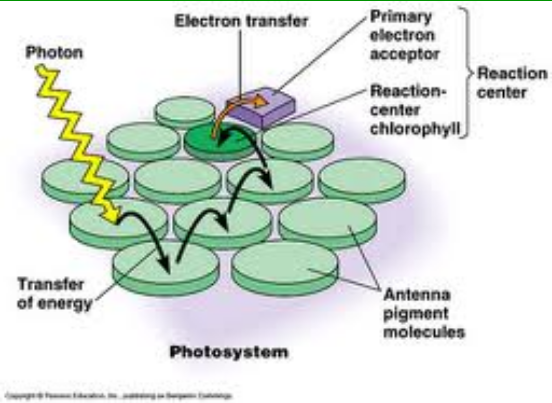
Steps of the light reactions
Electrons of hydrogens on chlorophyll in photo-system 2 (p680) are excited by visible rays (blue and red light) and move to the reaction center (actually whole H) (thomas is reaction center)
These electrons leave the reaction center (thomas) on the primary electron acceptor (Ms. Chamness) (proton, e-split)
Simultaneously, light energy splits water and with the help of enzymes the H and electrons from water are put on chlorophyll to replace the ones that are leaving - oxygen is given off as as bi-product and goes off into the atmosphere
The two Photosystems
sun exciting electron of hydrogen
electron pass through ETC
loses some energy (not all!) to pump H+
(1 ATP made per electron)
electrons are received by a second photosystem
they’re re-excited to higher E level!
passed on to calvin cycle by NADPH carrier
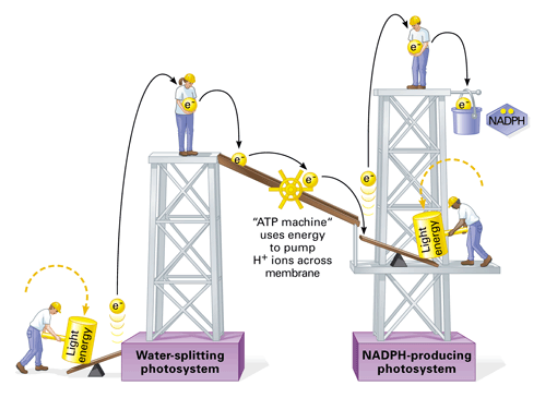
Flow of electron through the photosystems (easy ver.)
Photosystem II (the first helper):
Think of PS II as a solar panel that loves catching light at 680 nm (a specific color of light).
When it catches light, it gets really excited and throws off an electron (like tossing a ball).
But uh-oh! Now it’s missing an electron.
So it splits a water molecule (H₂O) to grab a new electron, which also releases protons (H⁺) and oxygen (O₂). That’s why plants make oxygen!
Electron's Adventure:
The tossed electron goes on a travel adventure through the Electron Transport Chain (ETC) — a kind of energy highway.
While zooming along, it helps pump H⁺ protons into the thylakoid, creating a battery-like charge.
Photosystem I (the next helper):
PS I loves catching light at 700 nm and gets super excited when it absorbs light.
It catches the traveling electron, recharges it, and tosses it to Ferredoxin (an iron helper).
Ferredoxin and NADPH:
Ferredoxin is like a delivery truck that carries the electron to NADP⁺, turning it into NADPH — a special molecule that holds energy and electrons.
Why H⁺ is Important:
Those H⁺ protons from water join back with electrons to make NADPH, and the rest are used to make ATP (plant energy snacks).
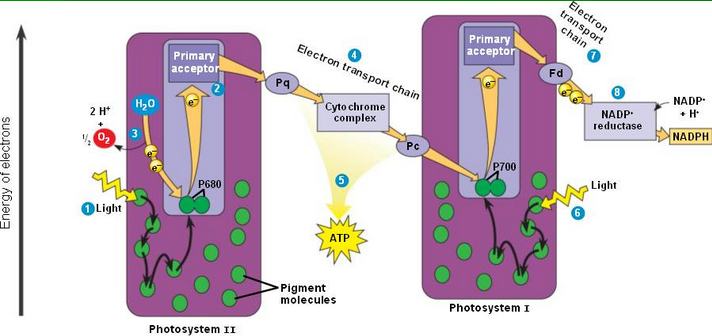
Flow of electrons through photosystems (hard ver.)
Photon Absorption (Photosystem II Activation):
Light strikes Photosystem II (PSII), exciting electrons in chlorophyll molecules at P680.
Water Oxidation (Electron Replenishment):
To replace lost electrons, water (H₂O) is oxidized at PSII, releasing oxygen gas (O₂), protons (H⁺), and electrons (e⁻).
This reaction provides electrons for the entire light reaction process.
Electron Transport (Energy Flow):
Excited electrons move from PSII through the Electron Transport Chain (ETC), passing through molecules like plastoquinone (PQ), cytochrome b6f, and plastocyanin (PC).
Proton Gradient Formation:
As electrons move through the ETC, protons (H⁺) are pumped into the thylakoid lumen, creating a proton concentration gradient.
ATP Production (Chemiosmosis):
Protons flow back into the stroma through ATP synthase, driving the conversion of ADP + Pᵢ into ATP. This process is called photophosphorylation.
Photosystem I (PSI Activation):
Electrons reach Photosystem I (PSI), where they are re-energized by light at P700.
NADPH Formation:
Energized electrons are transferred to ferredoxin (Fd) and then to NADP⁺ reductase, which reduces NADP⁺ to form NADPH.
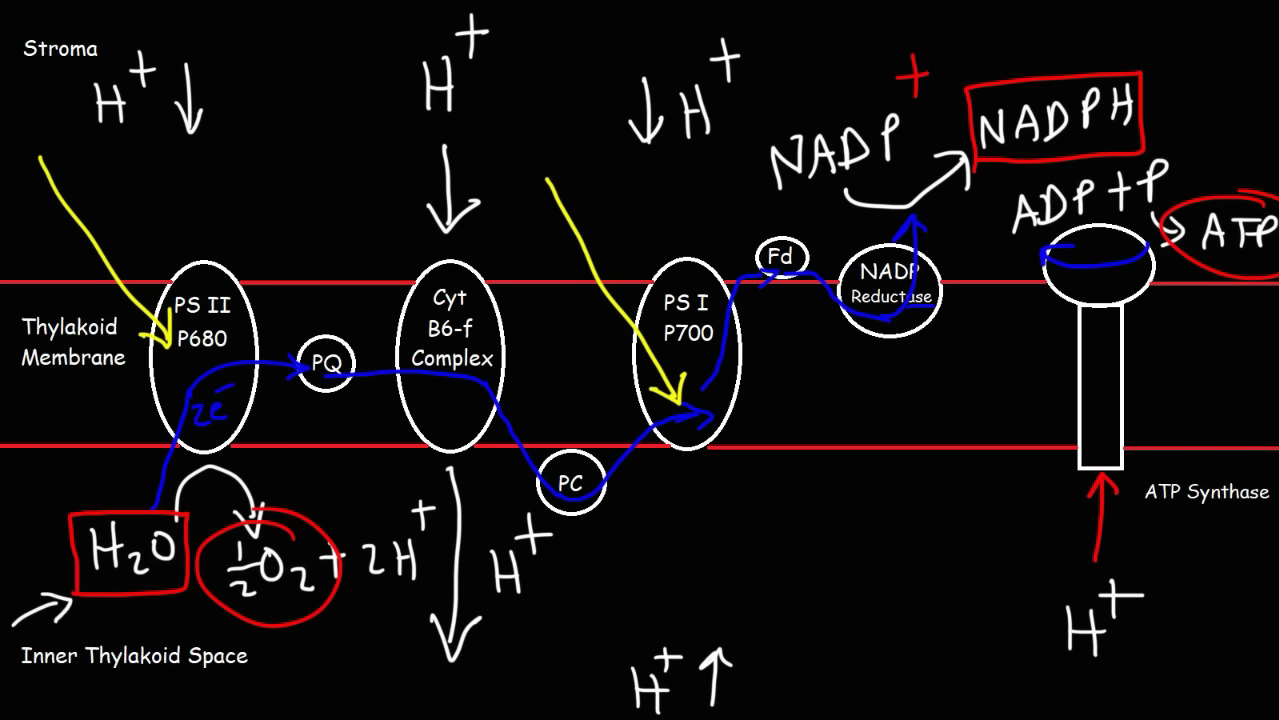
Chemiosmosis
As e- are passed down the etc, energy is lost
That energy is used to pump H+ into the thylakoid
The H+ flow back to the stroma through specifically shaped protein channels which contain the enzyme ATP synthase
The flow of H+ causes a shape change in the enzyme that allow it to catalyze adding P to ADP to make ATP
Using the sun’s energy to generate ATP through chemiosmosis is called photo-phosphorylation
Cyclic vs. Non Cyclic Photophosphorylation
Non-cyclic is the ATP generated from the electrons going straight through the path from water to NADPH.
Cyclic is the ATP created from the electrons being passed from Fd (Ferredoxin) back thru the e.t.c. a 2nd time to make more ATP.
Once the electrons are on Fd it can either pass them on to NADP+ or back to the e.t.c. Different enzymes transfer the e- each way and which way each goes is dependent on which enzyme grabs the e- first. Therefore it is concentration dependent
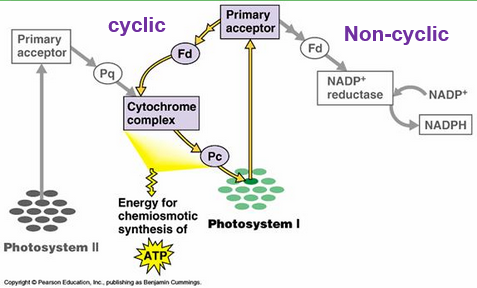
Calvin Cycle
takes place in the stroma
1 molecule of CO2 is added to RuBP (5 C) by the enzyme RUBISCO forming a 6 carbon intermediate (Carbon Dioxide Fixation)
The 6 carbon immediately breaks into 2 3-C phosphoglycerate
ATP is used to add a P to each phosphoglycerate
The high energy e- and H+ are then added from NADPH - making G3P
Each turn of the Calvin Cycle makes 2 G3P molecule.
After 3 cycles, the plant has produced 6 G3P molecules.
Out of those 6 G3Ps, 1 G3P is used to make sugars and other plant materials, while the other 5 G3Ps are recycled.
The 5 G3Ps are reworked to regenerate 3 RuBP molecules, which are essential to keep the Calvin Cycle going.
The one extra G3P not used for RUBP is a useable sugar and is converted to glucose etc.
Why Can’t The Calvin Cycle Happen At Night?
You need the high energy electrons from the light reactions and you can’t get them without the light.
The stomates close at night to conserve water and no CO2 is available
Rubisco – the enzyme that puts CO2 on RuBP is light sensitive.
Photorespiration
Rubisco can also bind to O2 and not just CO2. It prevents CO2 fixation. This is called photorespiration which is always bad for the plant because it slows down photosynthesis
C3 vs C4 vs CAM
C3 Plants (The Normal Plants) 🌱
These plants live in places where the weather is nice and not too dry.
They just grab carbon dioxide (CO₂) from the air and make sugar right away using the Calvin Cycle.
Easy peasy, but if it gets too hot or dry, they start to lose water and make mistakes by accidentally grabbing oxygen (O₂) instead of CO₂. That messes up their sugar-making.
Examples: Rice, wheat, and most trees.
C4 Plants (The Clever Sunny Plants) 🌽
These plants live in sunny, hot places.
They have a special trick: instead of using CO₂ right away, they store it in a safe box (bundle sheath cells) as a special molecule called malate.
When the weather is hot, they can still make sugar without messing up because the CO₂ is already locked and ready.
Examples: Corn, sugarcane, and some grasses.
CAM Plants (The Night Owls) 🌵
These plants live in super dry, desert-like places.
They say, "It's too hot during the day to open my doors!"
So they breathe at night, grabbing CO₂ and storing it as a special acid.
During the day, they close their doors to keep water in and use the stored CO₂ to make sugar.
Examples: Cacti, succulents, and pineapples.
Quick Recap:
C3: Chill and simple but bad in heat.
C4: Clever with a CO₂ storage trick for hot days.
CAM: Night owls that store CO₂ at night to survive deserts. 🌞🌙
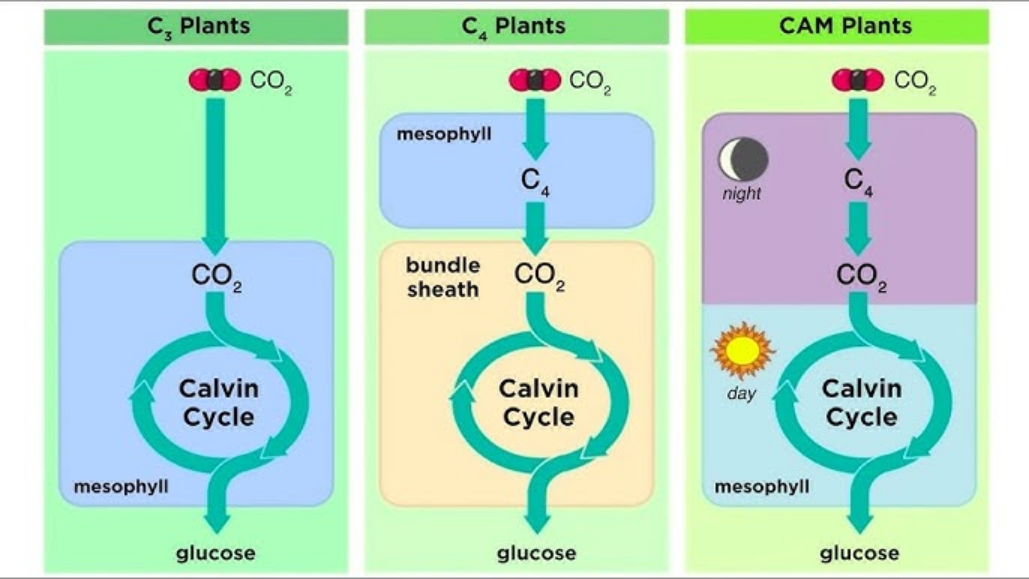
C4
C4 Plant Adaptations:
Includes sugar cane, corn, and grasses.
Thrive in hot, sunny environments due to specialized leaf structure.
Leaf arrangement conserves water instead of focusing on capturing extra light.
Mesophyll Cells:
CO₂ combines with PEP (phosphoenolpyruvate) using the enzyme PEP carboxylase (PEPCO) to form a 4-carbon compound.
PEPCO isn’t inhibited by oxygen (O₂), unlike Rubisco in C3 plants.
Bundle Sheath Cells:
The 4-carbon product diffuses into the bundle sheath cells, where it releases CO₂.
Rubisco uses this concentrated CO₂ to perform photosynthesis efficiently without oxygen interference.
C4 Pathway Advantage:
Helps solve the problem of low CO₂ concentration when stomata (leaf pores) are closed to prevent water loss.
By concentrating CO₂, photosynthesis continues even under limited CO₂ availability.
If this were a C3 plant, CO₂ would be spread out across the leaf, reducing photosynthesis efficiency.
Limitations:
This system does not work well in desert environments, which are both hot and extremely dry.
Desert plants (CAM plants) have a better strategy for handling extreme dryness.
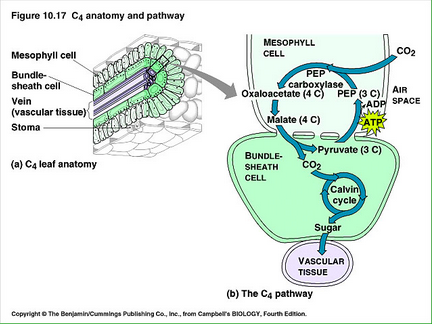
CAM
CAM Plants Adaptations:
Include cacti, succulents, and nearly all desert plants.
Thick, waxy cuticles prevent water loss through evaporation.
Specialized root systems:
Deep roots tap into groundwater.
Shallow roots spread near the surface to collect rain quickly.
Leaves are reduced to sharp needles, minimizing surface area to reduce water loss.
Poor for capturing sunlight, but this isn’t a problem in sunny deserts.
Chemical Adaptation for Photosynthesis:
CAM plants follow the C3 pathway but handle CO₂ collection differently.
Stomata open only at night to collect CO₂.
Desert nights are cold, reducing water evaporation.
No photosynthesis occurs at night since light is required for the light reactions.
CO₂ Storage:
CO₂ binds to organic acids throughout the night, storing it until sunrise.
This continues until all available organic acid is used up.
Daytime Photosynthesis:
Stomata close at sunrise to conserve water.
Stored CO₂ is used for photosynthesis.
Light reactions produce ATP and NADPH, which are used with CO₂ to run the Calvin Cycle.
Survival vs Growth:
CAM plants only produce enough energy to survive, not to grow significantly.
This is why CAM plants, like cacti, tend to stay small despite thriving in extreme environments.
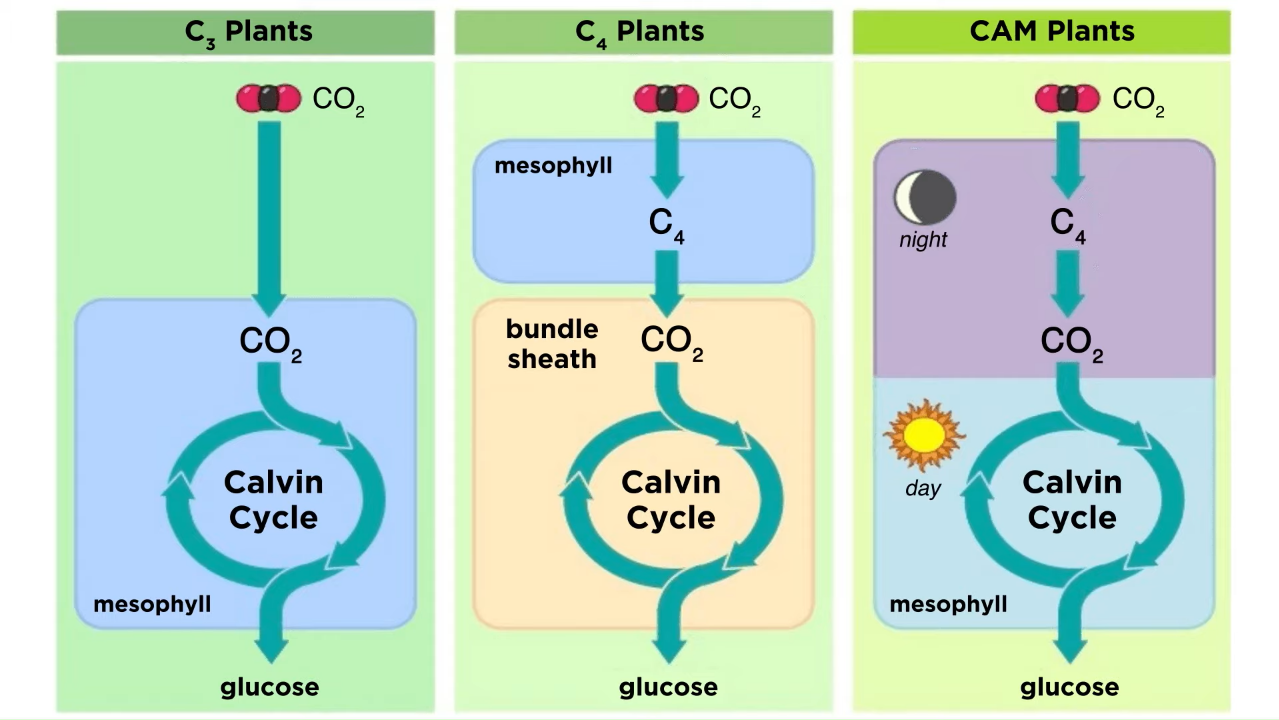
Temperature
As temperature increases, the enzymes involved in photosynthesis are moving faster--and so are the substrates (CO2, RUBP, water, etc) causing more collisions and more reactions until it gets so hot that the enzymes and carriers denature
Practical applications:
Plants grow best at moderately warm temp. → this is why grass doesn’t grow well in March but picks up growth in May
But why does it decrease toward August?
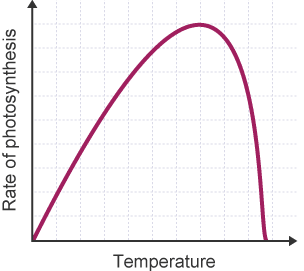
Light Intensity
If one photon of light hits a chloroplast, then only one electron will be excited and leave; if 2 hit 2 leave - so as the light gets stronger, more electrons will leave chlorophyll and go to NADPH to go into the sugar, until the electrons are hopping off so fast there aren’t enough enzymes to transfer them or enough molecules to accept them so it levels off. Also limited by the number of photosystems and chlorophyll because those electrons can only be excited and transferred and replaced so fast.
Practical application:
Due to its position the equator receives more direct light - higher light intensity - more photosynthesis → more plant biodiversity & quantity
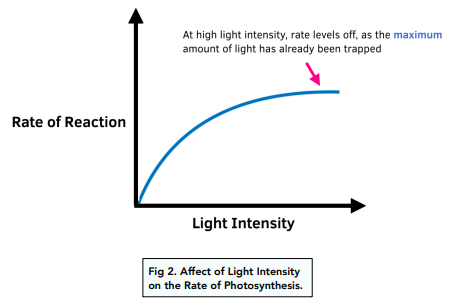
CO2
As CO2 increases, the rate increases because CO2 is a substrate so there is more to collide with RUBP and Rubisco enzyme so the reactions go faster but level off when all of the enzymes are busy and also limited by RUBP and NADPH and ATP to keep the reactions going.
Practical application:
CO2 doesn’t change in the air, but when stomates close because it is too hot, the CO2 keeps decreasing, slowing the rate of photosynthesis
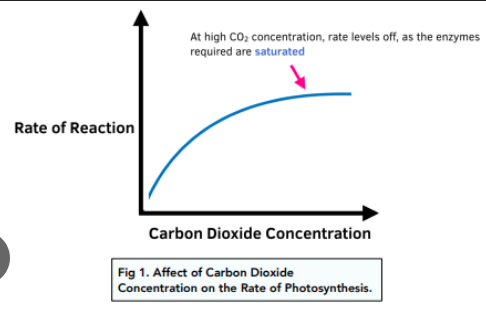
pH
As pH increases or decreases from the optimal - enzymes denature and photosynthesis decreases
Practical application:
Acid rain causes soil to become
acidic slowing the growth of
plants - so we put down base to
neutralize on a yearly basis.
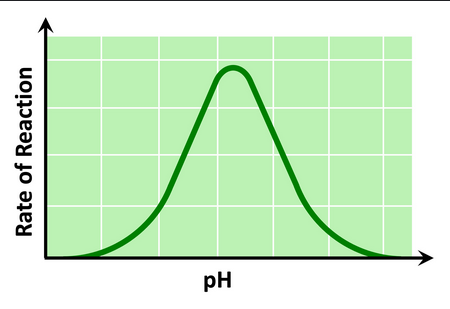
Water
Without water there is no H to replace the ones leaving chlorophyll, as water increases, you are replacing the H faster until they are replaced as fast as they leave - then it can’t go any faster. The rate the electrons leave is affected by the number of acceptors and enzymes and this would not change throughout the experiments
Practical application: Without water - not photo because you can’t replace the H on chlorophyll - Rain is a necessity for plant growth
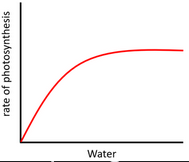
Oxygen
Oxygen competitively inhibits Rubisco so as oxygen increases (due to stomates closing so it can’t diffuse out), the rate of photosynthesis decreases as Rubisco is busy with O2 vs. combining CO2 with RuBP. It won’t go to zero since O2 hydrogen bonds and when it pops out, some CO2 can go in.
Practical Application: When dry and hot, stomates close causing photorespiration - sticking O2 onto RUBP, so this will slow down photosynthesis. This necessitates the C4 adaptation in the grasslands because the stomates are closed for long periods of time preventing photosynthesis
